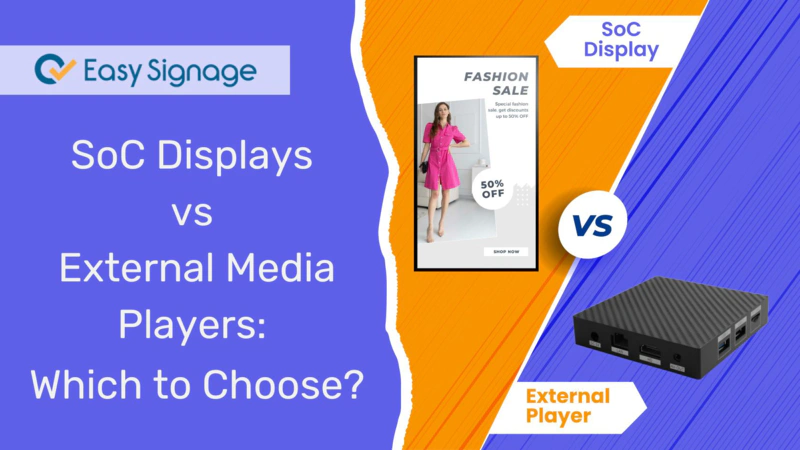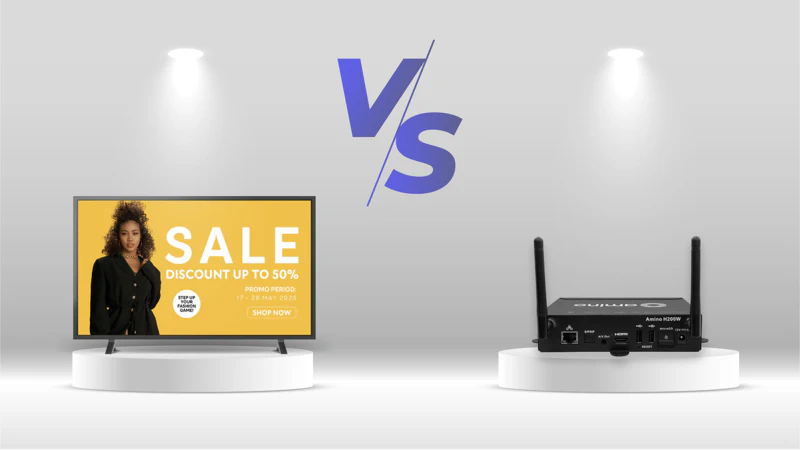SoC Displays vs External Media Players: Which to Choose?

Digital signage is used for various applications, from menu boards to lobby displays. However, when it comes to choosing the right hardware for your digital signage, it can be confusing and overwhelming, especially when deciding between a smart display with a built-in SoC or an external media player.
Both options are used in digital signage and have their advantages, but which one is the best match for your needs? By understanding the differences between SoC displays and external media players, you will make a smarter choice.
Let’s take a closer look at each option, how they differ in terms of performance, cost, flexibility, and which might be the best fit for your business.
What is an SoC Display?
SoC stands for System on Chip. It’s like a smart display that has a built-in media player. Instead of needing a separate device, a SoC display has all the components for media playback within the screen itself, creating an “all-in-one” solution.
No need for extra hardware.
All components, including CPU, GPU, memory, and storage, are on a single chip inside the screen.
It’s cable-free and ideal for a minimalist setup. You simply power it on, connect to the internet, and you’re good to go.
It offers a lower setup cost, as fewer devices need to be purchased and installed.
What are External Media Players?
An external media player is a separate device that is plugged in and connects to your screen, usually via HDMI or USB.
Dedicated performance: These players often feature powerful CPUs and GPUs for seamless playback of 4K content, video walls, or HD motion graphics.
Flexible Operating System: you can install custom apps on various OS like Windows, Android, Linux, or proprietary options (such as EasySignage player, BrightSign, Amino, or even small PCs).
Easier upgrades: You can easily swap out hardware or update software without needing to replace the entire screen.
More I/O ports: They provide additional input/output options, including USB, GPIO, serial ports, and more, which can be used for sensors or interactive features.
These external players sit behind the screen or nearby.
External media players are ideal when you want more control, more features, or the ability to upgrade your setup independently of your screen.
Key Differences Between SoC Displays and External Media Players
Choosing between an SoC and an external solution requires balancing ease of use with power and flexibility. Here’s a quick side-by-side comparison:
- Hardware Setup
- SoC Display: An all-in-one solution.
- External media Player: A separate device with its own display.
- Performance
- SoC Display: Suitable for static images, simple videos, basic HTML5 with limited processing power.
- External media Player: Offers high performance, is upgradeable, and can handle high-bitrate 4K content.
- Maintenance
- SoC Display: Fewer cables and components; requires firmware updates for the screen.
- External Media Player: Easier to troubleshoot and replace, since it is a separate unit.
- Cost
- SoC Display: Generally lower upfront cost; screen + player = one purchase.
- External Media Player: Higher hardware cost, but more scalable and pay-as-you-grow upgrade path.
- Flexibility
- SoC Display: Limited to the specific display model.
- External Media Player: Provides more flexibility in terms of content and operating systems.
- Software Updates
- SoC Display: Updates are slower and dependent on the vendor.
- External Media Player: Supports faster updates and customizable options.
- Scalability
- SoC Display: Suitable for small to medium networks.
- External Media Player: Ideal for larger networks and video walls.
Quick Summary
- SoC displays are simple and affordable for basic needs.
- External players are better suited for high-demand applications, interactive, or large networks.
Think performance vs. plug-and-play.

SoC vs External Players: Which One Should You Choose?
Your choice depends on your specific needs and project goals:
✅ Choose SoC (System on Chip) if:
- You want an easy setup and a plug-and-play experience.
- You are installing a few screens in a retail shop or café.
- You prefer a single-unit solution with fewer cables and devices.
- You are working with a small budget for deployment.
- SoC displays can be an ideal solution for digital menu boards.
For straightforward, budget-friendly projects: opt for SoC displays.
✅ Choose an External Media Player if:
- You require complex content for digital signage, 4K motion graphics, custom applications, or multi-screen setups.
- You want the flexibility to upgrade or scale your system without replacing the screens.
- You work in settings like airports, campuses, or large digital networks.
For enhanced performance, flexibility, and future-proofing: choose external media players.
The Bottom Line
Both SoC displays and external media players have their strengths. SoC displays are simple and sleek, while external players offer greater power and flexibility.
Your choice should be based on your specific setup size, content requirements, and the level of flexibility you want.
Either way, using a reliable content management system (CMS) like EasySignage will ensure that your content stands out!